turn signal CADILLAC CTS 2007 1.G User Guide
[x] Cancel search | Manufacturer: CADILLAC, Model Year: 2007, Model line: CTS, Model: CADILLAC CTS 2007 1.GPages: 518, PDF Size: 2.77 MB
Page 181 of 518
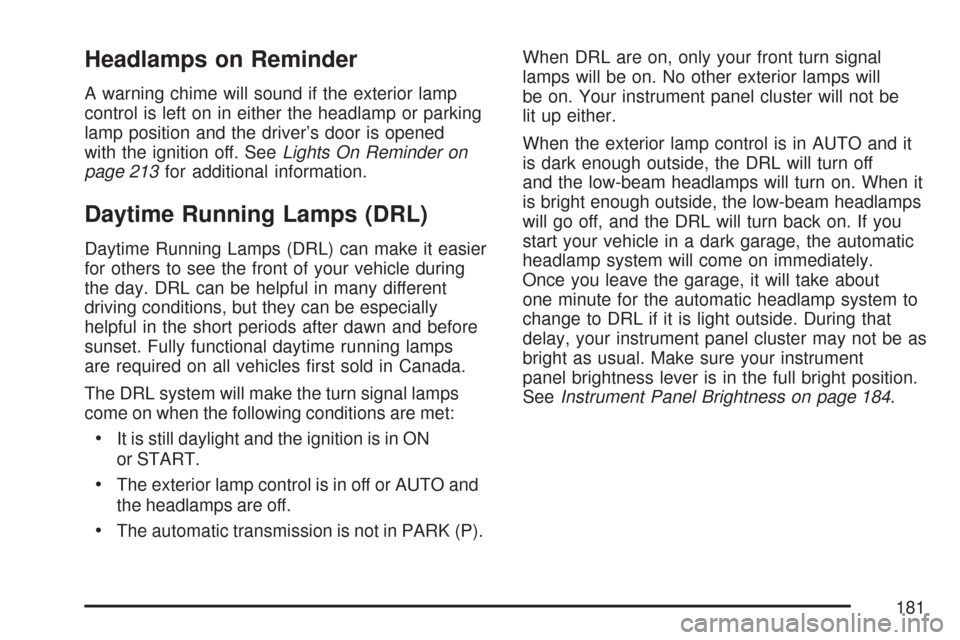
Headlamps on Reminder
A warning chime will sound if the exterior lamp
control is left on in either the headlamp or parking
lamp position and the driver’s door is opened
with the ignition off. SeeLights On Reminder on
page 213for additional information.
Daytime Running Lamps (DRL)
Daytime Running Lamps (DRL) can make it easier
for others to see the front of your vehicle during
the day. DRL can be helpful in many different
driving conditions, but they can be especially
helpful in the short periods after dawn and before
sunset. Fully functional daytime running lamps
are required on all vehicles �rst sold in Canada.
The DRL system will make the turn signal lamps
come on when the following conditions are met:
It is still daylight and the ignition is in ON
or START.
The exterior lamp control is in off or AUTO and
the headlamps are off.
The automatic transmission is not in PARK (P).When DRL are on, only your front turn signal
lamps will be on. No other exterior lamps will
be on. Your instrument panel cluster will not be
lit up either.
When the exterior lamp control is in AUTO and it
is dark enough outside, the DRL will turn off
and the low-beam headlamps will turn on. When it
is bright enough outside, the low-beam headlamps
will go off, and the DRL will turn back on. If you
start your vehicle in a dark garage, the automatic
headlamp system will come on immediately.
Once you leave the garage, it will take about
one minute for the automatic headlamp system to
change to DRL if it is light outside. During that
delay, your instrument panel cluster may not be as
bright as usual. Make sure your instrument
panel brightness lever is in the full bright position.
SeeInstrument Panel Brightness on page 184.
181
Page 183 of 518
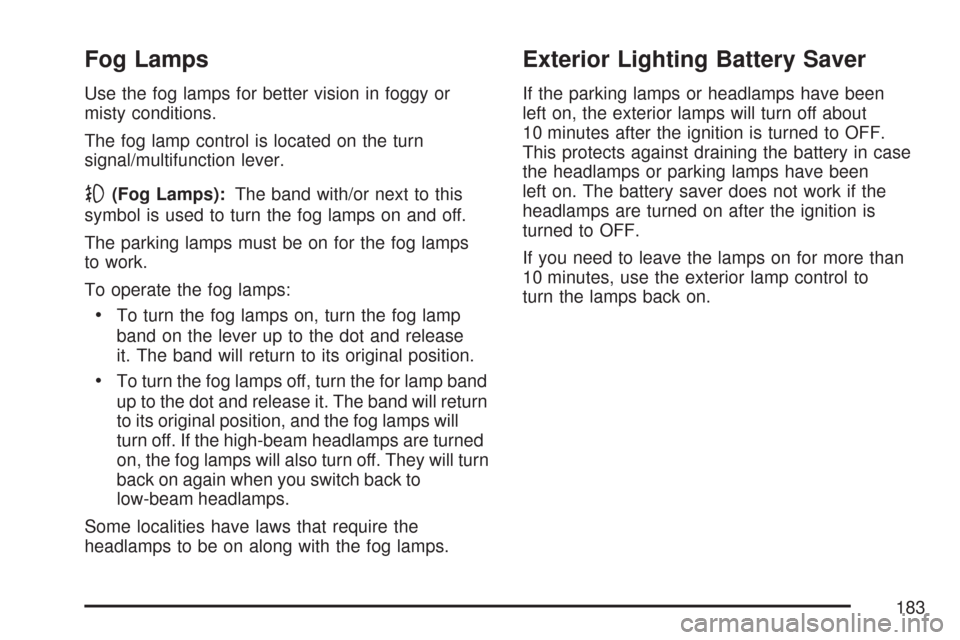
Fog Lamps
Use the fog lamps for better vision in foggy or
misty conditions.
The fog lamp control is located on the turn
signal/multifunction lever.
-(Fog Lamps):The band with/or next to this
symbol is used to turn the fog lamps on and off.
The parking lamps must be on for the fog lamps
to work.
To operate the fog lamps:
To turn the fog lamps on, turn the fog lamp
band on the lever up to the dot and release
it. The band will return to its original position.
To turn the fog lamps off, turn the for lamp band
up to the dot and release it. The band will return
to its original position, and the fog lamps will
turn off. If the high-beam headlamps are turned
on, the fog lamps will also turn off. They will turn
back on again when you switch back to
low-beam headlamps.
Some localities have laws that require the
headlamps to be on along with the fog lamps.
Exterior Lighting Battery Saver
If the parking lamps or headlamps have been
left on, the exterior lamps will turn off about
10 minutes after the ignition is turned to OFF.
This protects against draining the battery in case
the headlamps or parking lamps have been
left on. The battery saver does not work if the
headlamps are turned on after the ignition is
turned to OFF.
If you need to leave the lamps on for more than
10 minutes, use the exterior lamp control to
turn the lamps back on.
183
Page 229 of 518

AF
ASEEK LOCAL/DISTANT
9(English/Metric Units)
TCS
8(Clock)
8/4(Clock/Information Display)
SETUP
DIC Main Menu Item Descriptions
e
BASS - MID (Midrange) - TREBLE:This
menu item allows you to adjust the levels for the
bass, midrange, treble, balance, and fade features
of the audio system. For more information, see
“Setting the Tone (Bass/Treble)” and “Adjusting the
Speakers (Balance/Fade)” underRadio with CD
on page 260.
eEQ (Equalizer):This menu item allows you to
choose among �ve preset equalizations for the
audio system. See “Audio Equalizer” underRadio
with CD on page 260for more information.DSP (Digital Signal Processing):If your vehicle
has a Bose
®Audio System, this menu item
allows you to select the DSP type that you want
on the audio system. You may choose Normal,
Talk, Spacious, Rear Seat, or Driver Seat. Press
the TUNE/SEL knob to scroll through these
choices. Once the desired choice is displayed,
turn the knob to set your DSP choice and continue
scrolling through the main menu.
See “Using DSP” underRadio with CD on
page 260for more information.
AVC (Automatic Volume Compensation):If your
vehicle has a Bose
®Audio System, this menu item
allows you to turn the AVC feature on and off. Press
the TUNE/SEL knob once to turn AVC on and off.
When AVC is on, an X will be in the box next to
AVC on the menu. The X disappears when AVC
is off.
See “AVC (Automatic Volume Compensation)”
underRadio with CD on page 260for more
information.
229
Page 230 of 518
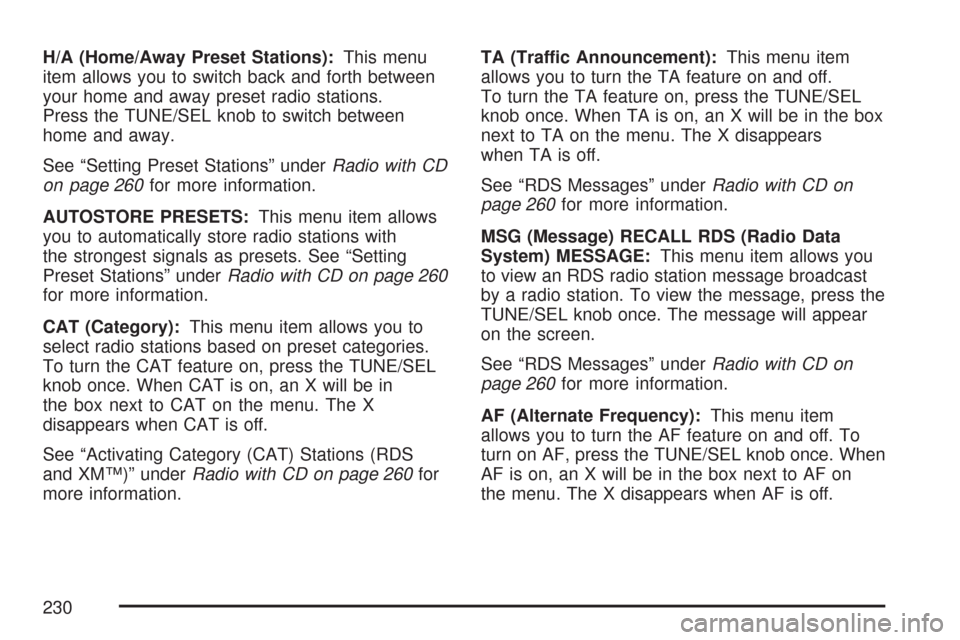
H/A (Home/Away Preset Stations):This menu
item allows you to switch back and forth between
your home and away preset radio stations.
Press the TUNE/SEL knob to switch between
home and away.
See “Setting Preset Stations” underRadio with CD
on page 260for more information.
AUTOSTORE PRESETS:This menu item allows
you to automatically store radio stations with
the strongest signals as presets. See “Setting
Preset Stations” underRadio with CD on page 260
for more information.
CAT (Category):This menu item allows you to
select radio stations based on preset categories.
To turn the CAT feature on, press the TUNE/SEL
knob once. When CAT is on, an X will be in
the box next to CAT on the menu. The X
disappears when CAT is off.
See “Activating Category (CAT) Stations (RDS
and XM™)” underRadio with CD on page 260for
more information.TA (Traffic Announcement):This menu item
allows you to turn the TA feature on and off.
To turn the TA feature on, press the TUNE/SEL
knob once. When TA is on, an X will be in the box
next to TA on the menu. The X disappears
when TA is off.
See “RDS Messages” underRadio with CD on
page 260for more information.
MSG (Message) RECALL RDS (Radio Data
System) MESSAGE:This menu item allows you
to view an RDS radio station message broadcast
by a radio station. To view the message, press the
TUNE/SEL knob once. The message will appear
on the screen.
See “RDS Messages” underRadio with CD on
page 260for more information.
AF (Alternate Frequency):This menu item
allows you to turn the AF feature on and off. To
turn on AF, press the TUNE/SEL knob once. When
AF is on, an X will be in the box next to AF on
the menu. The X disappears when AF is off.
230
Page 231 of 518

See “Activating Category (CAT) Stations (RDS
and XM™)” underRadio with CD on page 260for
more information.
ASEEK LOCAL/DISTANT:This feature instructs
the audio system to seek only local radio stations
with the strongest signal or to seek all radio stations
with a strong signal in a large area. Use LOCAL
when you are in urban areas where there are
several strong radio station signals and you want to
limit the number of stations to those with the
strongest signals only. Use DISTANT when you are
in rural areas where there are fewer radio station
signals available.
To switch between LOCAL and DISTANT, press
the TUNE/SEL knob. Once your choice is
displayed, turn the knob to set your choice and
continue scrolling through the main menu.
9(English/Metric Units):Use this menu item
to adjust the measurement units.
You can choose between ENGLISH UNITS and
METRIC UNITS. To switch between the two, press
the TUNE/SEL knob. Once your choice is
displayed, turn the knob to set your choice and
continue scrolling through the main menu.The measurement units that you choose will be
re�ected on all the vehicle system displays,
not just the DIC information. For example, the
climate control panel will display degrees Celsius
if you choose METRIC UNITS.
TCS (Traction Control System):You can enable
or disable the Traction Control System (TCS)
using this menu item. Press the TUNE/SEL knob
to switch between on and off.
You can also turn the TCS off using the traction
control button located in the glove box (CTS) or on
the steering wheel (CTS-V), or by programming
one of the steering wheel controls (1, 2, 3, or 4) or
audio system soft keys to enable/disable the
TCS. SeeRecon�gurable Steering Wheel Controls
(SWC) (CTS) on page 169and “Con�gurable
Radio Display Keys” underRadio with CD
on page 260for more information.
When you disable the TCS, the traction control
system warning light on the instrument panel
cluster will come on. SeeTraction Control System
(TCS) Warning Light on page 206for more
information.
231
Page 242 of 518

Top Speed – Fuel Cut Off
This message will appear when the Engine
Control Module (ECM) detects that the maximum
speed for your vehicle has been reached. Your
vehicle’s top speed is based on the top speed
rating of the tires. This ensures that your vehicle
stays in a safe operating range for the tires.
Traction Engaged
This message will appear when the Traction
Control System (TCS) is actively limiting wheel
spin. Slippery road conditions may exist if
this message is displayed, so adjust your driving
accordingly. The message will stay on for a
few seconds after the TCS stops limiting wheel
spin. SeeTraction Control System (TCS) (CTS) on
page 293orTraction Control System (TCS)
(CTS-V) on page 295for more information.
Trans (Transmission) Hot – Idle Engine
This message indicates that the transmission
�uid in your vehicle is too hot. Stop the vehicle and
allow it to idle until the transmission cools down
or until this message is removed. See also
Transmission Fluid Hot Message on page 219for
more information.
Trunk Open
When this message appears on the display, it
means that the trunk lid of your vehicle was not
closed completely. You should make sure that the
trunk lid is closed completely.
Turn Signal On
If you drive your vehicle for more than about
1 mile (1.6 km) with a turn signal on, this message
will appear as a reminder to turn off the turn
signal. A multiple chime will sound when this
message is displayed.
DIC Vehicle Personalization
If your vehicle has the Navigation system, see the
Navigation system manual for instructions on
operating the DIC for your vehicle.
Your vehicle has personalization that allows you to
program certain features to a preferred setting
for up to two people. The number of programmable
features varies depending upon which model of
the vehicle is purchased.
242
Page 262 of 518
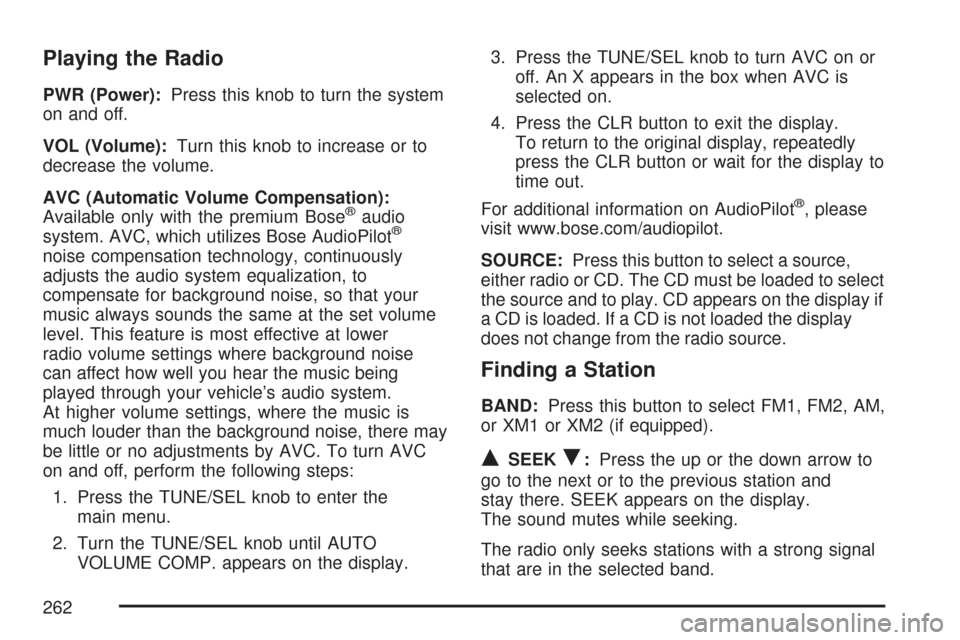
Playing the Radio
PWR (Power):Press this knob to turn the system
on and off.
VOL (Volume):Turn this knob to increase or to
decrease the volume.
AVC (Automatic Volume Compensation):
Available only with the premium Bose
®audio
system. AVC, which utilizes Bose AudioPilot®
noise compensation technology, continuously
adjusts the audio system equalization, to
compensate for background noise, so that your
music always sounds the same at the set volume
level. This feature is most effective at lower
radio volume settings where background noise
can affect how well you hear the music being
played through your vehicle’s audio system.
At higher volume settings, where the music is
much louder than the background noise, there may
be little or no adjustments by AVC. To turn AVC
on and off, perform the following steps:
1. Press the TUNE/SEL knob to enter the
main menu.
2. Turn the TUNE/SEL knob until AUTO
VOLUME COMP. appears on the display.3. Press the TUNE/SEL knob to turn AVC on or
off. An X appears in the box when AVC is
selected on.
4. Press the CLR button to exit the display.
To return to the original display, repeatedly
press the CLR button or wait for the display to
time out.
For additional information on AudioPilot
®, please
visit www.bose.com/audiopilot.
SOURCE:Press this button to select a source,
either radio or CD. The CD must be loaded to select
the source and to play. CD appears on the display if
a CD is loaded. If a CD is not loaded the display
does not change from the radio source.
Finding a Station
BAND:Press this button to select FM1, FM2, AM,
or XM1 or XM2 (if equipped).
QSEEKR:Press the up or the down arrow to
go to the next or to the previous station and
stay there. SEEK appears on the display.
The sound mutes while seeking.
The radio only seeks stations with a strong signal
that are in the selected band.
262
Page 263 of 518

QSCANR:Press the SCAN button to enter
scan mode. SCAN appears on the display.
Press the up arrow to scan to the next station.
The radio goes to a station, plays for �ve seconds,
then goes to the next station. Press this button
again to stop scanning.
To scan preset stations, press and hold SCAN for
more than two seconds until you hear a beep
and PSCAN appears on the display. The radio
goes to the �rst preset station stored on your �rm
keys, plays for �ve seconds, then goes to the
next preset station. Press SCAN again to
stop scanning presets.
The radio only scans stations with a strong signal
that are in the selected band.
LOCAL/DISTANT Selection:With this feature you
can set the radio to search for local stations or
stations that are further away for a larger selection.To set this feature to LOCAL or DISTANT, perform
the following steps:
1. Press the TUNE/SEL knob to enter the
main menu.
2. Turn the TUNE/SEL knob until SEEK LOCAL
or SEEK DISTANT appears on the display.
3. Press the TUNE/SEL knob to select either
LOCAL or DISTANT.
4. Press the CLR button to exit the display.
To return to the original display, repeatedly
press the CLR button or wait for the display to
time out.
To search for stations, press the SEEK up or down
arrows. If the system is set to LOCAL, SEEK
appears in the display and seeks to stations with
strong signals only. If the system is set to
DISTANT, D-SEEK appears in the display and
seeks to stations with weak and strong signals.
263
Page 264 of 518
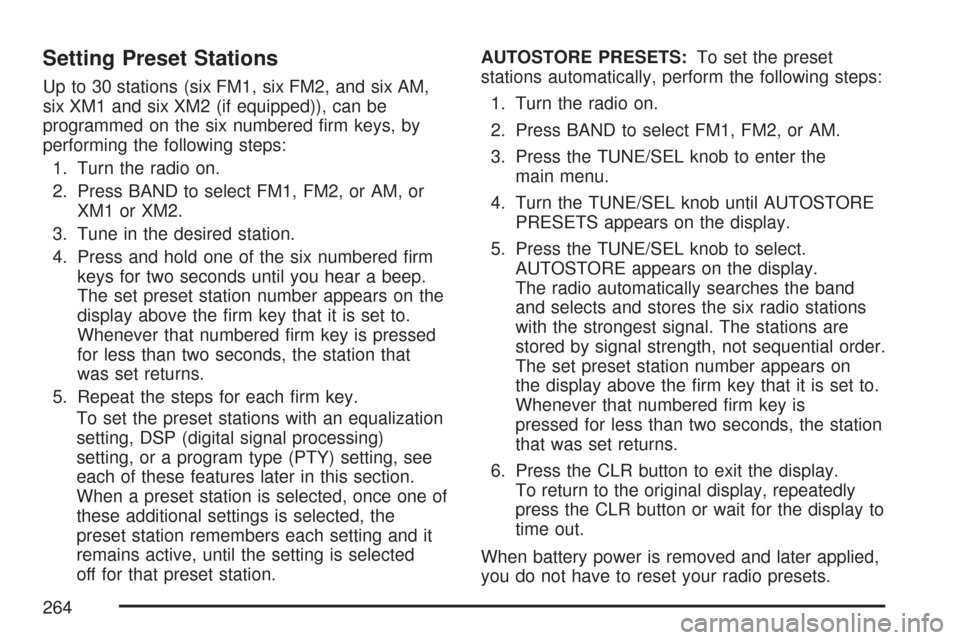
Setting Preset Stations
Up to 30 stations (six FM1, six FM2, and six AM,
six XM1 and six XM2 (if equipped)), can be
programmed on the six numbered �rm keys, by
performing the following steps:
1. Turn the radio on.
2. Press BAND to select FM1, FM2, or AM, or
XM1 or XM2.
3. Tune in the desired station.
4. Press and hold one of the six numbered �rm
keys for two seconds until you hear a beep.
The set preset station number appears on the
display above the �rm key that it is set to.
Whenever that numbered �rm key is pressed
for less than two seconds, the station that
was set returns.
5. Repeat the steps for each �rm key.
To set the preset stations with an equalization
setting, DSP (digital signal processing)
setting, or a program type (PTY) setting, see
each of these features later in this section.
When a preset station is selected, once one of
these additional settings is selected, the
preset station remembers each setting and it
remains active, until the setting is selected
off for that preset station.AUTOSTORE PRESETS:To set the preset
stations automatically, perform the following steps:
1. Turn the radio on.
2. Press BAND to select FM1, FM2, or AM.
3. Press the TUNE/SEL knob to enter the
main menu.
4. Turn the TUNE/SEL knob until AUTOSTORE
PRESETS appears on the display.
5. Press the TUNE/SEL knob to select.
AUTOSTORE appears on the display.
The radio automatically searches the band
and selects and stores the six radio stations
with the strongest signal. The stations are
stored by signal strength, not sequential order.
The set preset station number appears on
the display above the �rm key that it is set to.
Whenever that numbered �rm key is
pressed for less than two seconds, the station
that was set returns.
6. Press the CLR button to exit the display.
To return to the original display, repeatedly
press the CLR button or wait for the display to
time out.
When battery power is removed and later applied,
you do not have to reset your radio presets.
264
Page 267 of 518
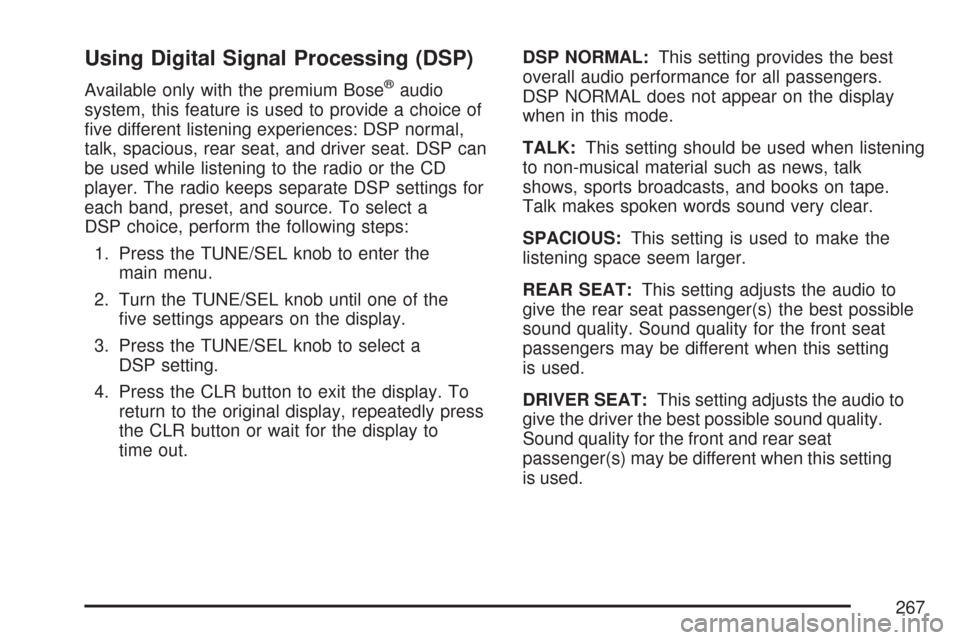
Using Digital Signal Processing (DSP)
Available only with the premium Bose®audio
system, this feature is used to provide a choice of
�ve different listening experiences: DSP normal,
talk, spacious, rear seat, and driver seat. DSP can
be used while listening to the radio or the CD
player. The radio keeps separate DSP settings for
each band, preset, and source. To select a
DSP choice, perform the following steps:
1. Press the TUNE/SEL knob to enter the
main menu.
2. Turn the TUNE/SEL knob until one of the
�ve settings appears on the display.
3. Press the TUNE/SEL knob to select a
DSP setting.
4. Press the CLR button to exit the display. To
return to the original display, repeatedly press
the CLR button or wait for the display to
time out.DSP NORMAL:This setting provides the best
overall audio performance for all passengers.
DSP NORMAL does not appear on the display
when in this mode.
TALK:This setting should be used when listening
to non-musical material such as news, talk
shows, sports broadcasts, and books on tape.
Talk makes spoken words sound very clear.
SPACIOUS:This setting is used to make the
listening space seem larger.
REAR SEAT:This setting adjusts the audio to
give the rear seat passenger(s) the best possible
sound quality. Sound quality for the front seat
passengers may be different when this setting
is used.
DRIVER SEAT:This setting adjusts the audio to
give the driver the best possible sound quality.
Sound quality for the front and rear seat
passenger(s) may be different when this setting
is used.
267